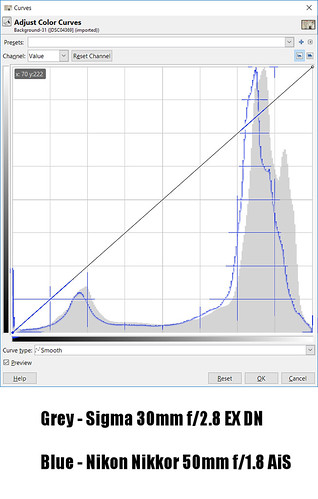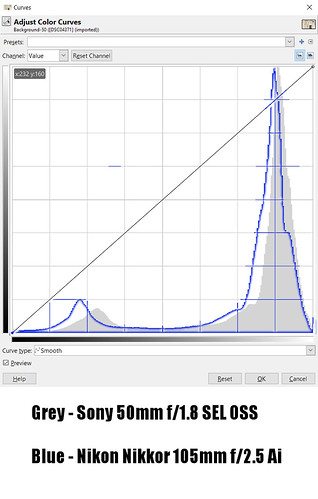There is, of course, much more to lenses in photography than just resolution (what we usually call "sharpness"). I've spent many many blog posts sharing what I've found in that regard. It is time to look at a different aspect of optics, cameras, and photography as tools.
Recently I've taken to working with Nikon lenses that in some cases are more than 50 years old. The resolution of the lenses match that of my modern lenses. They are all manual focus and change my approach to image making by slowing me down. After seeing some initial images, I was thrilled.
Without any direct evidence I felt the old Nikkors were more "contrasty". Again without any direct evidence and without understanding how such a thing could be possible I felt that new lenses somehow gave lower overall "contrast" but better "micro-contrast" than the old optics.
Thinking about this a bit, I devised a small comparison. Here is what I did.
I photographed the same scene with matching in-camera cropping using new and old lenses. Then I found a way to overlay the RGB/Luminosity "curves" to compare how lenses handled the light range.
The lenses I looked at were -
Recently I've taken to working with Nikon lenses that in some cases are more than 50 years old. The resolution of the lenses match that of my modern lenses. They are all manual focus and change my approach to image making by slowing me down. After seeing some initial images, I was thrilled.
Without any direct evidence I felt the old Nikkors were more "contrasty". Again without any direct evidence and without understanding how such a thing could be possible I felt that new lenses somehow gave lower overall "contrast" but better "micro-contrast" than the old optics.
Thinking about this a bit, I devised a small comparison. Here is what I did.
I photographed the same scene with matching in-camera cropping using new and old lenses. Then I found a way to overlay the RGB/Luminosity "curves" to compare how lenses handled the light range.
The lenses I looked at were -
- Sigma 19mm f/2.8 EX DN
- Sigma 30mm f/2.8 EX DN
- Sony 50mm f/1.8 SEL OSS
- Nikon Nikkor 24mm f/2.8 AiS
- Nikon Nikkor 28mm f/3.5 Ai + Lens Turbo II
- Nikon Nikkor 50mm f/1.8 AiS + Lens Turbo II
- Nikon Nikkor 105mm f/2.5 Ai + Lens Turbo II
All lenses were shot at f/5.6.
After photographing the scene I found I needed to match where the top and bottom of the "curve" touched the data recorded by the camera. I needed to do this because the exposure system in the camera never exactly matched lens to lens, frame to frame. This step is also rather important to my understanding of what's going on, as we will soon see.
Here are the results -
To begin with, the old manual focus lenses seem to in general place image information slightly lower than modern optics. The highlight and shadow peaks are consistently behind where the new Sigma and Sony lenses place them. Could the be an effect of the camera system taking a slightly different path to calculating exposure? Instead of balancing aperture, shutter speed and ISO, with manual focus lenses only the shutter speed and ISO are directly controllable by the system.
Additionally, I see is that with the shorter focal length lenses there is a slight difference in how the highlights are rendered. The highlight portion of the curve is broader with the new Sigmas than it is with the old Nikkors. The longer lenses, on the other hand, appear to have nearly identically shaped curves. Are the differences in curve shape in the highlights due to optical properties or by the way the camera system, again, calculates exposure by moving the highlight peak up the curve and thereby "spreading" the peak?
Then when I think about how I generated these illustrations in the first place (trying my best to match where the tops and bottoms of the curve first encountered recorded information). I quickly understand that it is entirely possible to more precisely match the shapes of the curves between any of the lenses.
Even without answering my questions about how the Sony NEX/Alpha cameras calculate exposure with fully automated and old manual no-aperture controlled lenses, I think I can safely share an interesting outcome of little comparison: After processing there is no meaningful difference in how new and old optics send light to a sensor. Said another way, in terms of "curves" shape I feel it is very likely possible to make a new lens "look" like and "old" one, and vice versa.
As for what started me down this path, that the old Nikon Nikkor lenses were more "contrasty" than modern optics, and that modern optics were somehow better able to render "micro-contrast", I see no evidence to support my feelings and earlier thoughts.
This is why I take the time to look at these kinds of things. I learn something nearly every time I take a deeper look at photographic tools.
Additionally, I see is that with the shorter focal length lenses there is a slight difference in how the highlights are rendered. The highlight portion of the curve is broader with the new Sigmas than it is with the old Nikkors. The longer lenses, on the other hand, appear to have nearly identically shaped curves. Are the differences in curve shape in the highlights due to optical properties or by the way the camera system, again, calculates exposure by moving the highlight peak up the curve and thereby "spreading" the peak?
Then when I think about how I generated these illustrations in the first place (trying my best to match where the tops and bottoms of the curve first encountered recorded information). I quickly understand that it is entirely possible to more precisely match the shapes of the curves between any of the lenses.
Even without answering my questions about how the Sony NEX/Alpha cameras calculate exposure with fully automated and old manual no-aperture controlled lenses, I think I can safely share an interesting outcome of little comparison: After processing there is no meaningful difference in how new and old optics send light to a sensor. Said another way, in terms of "curves" shape I feel it is very likely possible to make a new lens "look" like and "old" one, and vice versa.
As for what started me down this path, that the old Nikon Nikkor lenses were more "contrasty" than modern optics, and that modern optics were somehow better able to render "micro-contrast", I see no evidence to support my feelings and earlier thoughts.
This is why I take the time to look at these kinds of things. I learn something nearly every time I take a deeper look at photographic tools.



No comments:
Post a Comment